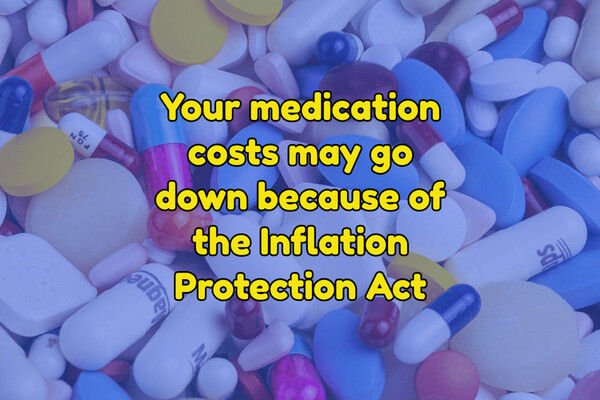
On August 16, 2022, Joe Biden, The President of the United States of America, signed the law of the Inflation Reduction Act of 2022. This Act covers a wide range of regulations on health, taxes, and climate change. The Act contains several provisions designed to reduce the cost of prescription drugs for people receiving Medicare and reduce federal government drug spending.
Why are drug costs an issue?
Many adults have difficulty paying for their prescription drugs. As of last year, many have not taken prescription medicines as directed because of the unreasonable cost of prescription drugs.
The help of this Inflation Reduction Act will improve health care affordability for Americans.
What are the Provisions for the Prescription Drug in the Inflation Reduction Act?
There are several provisions that the senate bill includes to lower drug costs and prices.
- The bill forces the federal government to negotiate prices for some of the best-selling drugs covered by Medicare. The current law prohibited the federal government from negotiating prices on behalf of the Medicare population.
- Drug companies are now required to pay rebates to Medicare beneficiaries if the prices rise faster than inflation for the drugs used. This requirement is in response to the annual increase in drug prices.
- $2000 cap on out-of-pocket spending under Medicare Part D. This is a big help for patients taking high-priced drugs for serious conditions like cancer. Also, this bill eliminates the 5% coinsurance for catastrophic coverage in Medicare Part D that will begin in 2024.
- Insulin products included in the Medicare plan now have a $35 per month limit.
- The Act expands eligibility for Medicare Part D low-income subsidy benefits. Low-income seniors are now eligible for financial help to better pay for their prescriptions.
- IRA also expands adult vaccine access by eliminating cost sharing for all adult vaccines under Medicaid and CHIP.
- The senate added delays in implementing the Trump Administration's drug rebate rule.
When will this Inflation Reduction Act come into force?
Below is the detailed timeline of implementation of the Prescription Drug Provisions in Inflation Reduction Act:
- 2023 - Starting in 2023, pharmaceutical companies will have to pay rebates to Medicare beneficiaries if their drug prices rise faster than inflation. The $35 monthly cap for insulin covered by Medicare will also take effect next year. Lastly, enrolled adults on Part D will not be charged coinsurance for adult vaccines.
- 2024 - When Medicare beneficiaries reach the catastrophic threshold, they no longer have to pay for coinsurance. And the extended entitlement to the Part D low-income subsidy offers full benefits.
- 2025 - A reduced amount of $2000 for the Part D out-of-pocket spending and other drug benefit charges.
- 2026 - 2029 - Implementation begins for Negotiated prices for certain expensive drugs.
In addition, Medicare Part D premiums will have a maximum limit of no more than 6% per annum from 2024 to 2030.
Drug Price Negotiation
The amended law now allows the Secretary of Health and Human Services (HHS) to negotiate with drug companies on Medicare drug prices for some drugs included in Medicare Part B (Medicare Retail Pharmacy Benefit) and Part D (Physician-Administered Drugs).
- Qualified drugs for price negotiation - The Secretary can only negotiate drugs selected from the 50 negotiable-eligible medications with the highest total expenditure in Medicare Part D and 50 negotiable-eligible medicines with the highest total expenditure in Medicare Part B. This part of the law includes brand-name drugs or biologics without generics or biosimilar equivalents. Medications should also be on the market for several years. It should not be less than nine years for small-molecule drugs or 13 years for biological products from the FDA approval or licensure date. Other drugs prohibited for negotiation include Drugs that account for Medicare spending of less than $200 million in 2021, certain "small biotech drugs" (From 2026-2028), and Drugs with an orphan designation as the only FDA-approved indication.
- The number of drugs qualified - Price negotiation will increase from 10 to 15 Part D drugs in 2027, 15 Part D and Part B drugs in 2028, and 20 Part B and Part D drugs in 2029.
- What is the "maximum fair price"? - The upper limit for the negotiated price of a drug is equal to the lowest of the Part D enrollment-weighted negotiated price, Part B average sales price, or the percentage of the non-federal average manufacturer's price of the drug, which is: 75% for low molecular weight drugs more than nine years but less than 12 years after FDA approval, 65% for drugs 12 to 16 years after FDA approval; and 40% for drugs that have elapsed more than 16 years since FDA approval.
- Penalties for non-compliance - Financial penalty in the form of excise tax, starting at 65% of drug sales in previous years and increasing by 10% quarterly to 95%. If drug manufacturers withdraw their drugs from Medicare and Medicaid coverage, they can get the tax waived.
2026 - 2027 Medicare Drug Price Negotiation Timeline:
The timetable for the negotiation process is approximately two years.
- September 1, 2023 - Published date of 10 Drug selected for negotiation (Part D program)
February 1, 2025 - Published date of 15 Drug selected for negotiation (Part D or Part B combined)
- October 1, 2023 - The negotiation process begins between the HHS secretary and drug manufacturers for 10
selected drugs (Part D program)
February 28, 2023 - The negotiation process for 15 selected drugs (Part D or Part B combined)
- August 1, 2024 - The end of the negotiation for ten selected drugs (Part D program)
November 1, 2025 - The negotiation process ends for 15 selected drugs (Part D or Part B combined)
- September 1, 2024 - Published date for the Maximum Fair Prices for ten selected drugs
November 20, 2025 - Published date for the Maximum Fair Prices for 15 selected drugs
- The year 2023 and 2027 - The effective year of the negotiated prices for 10 and 15 selected drugs.
Inflation Limit
The new bill requires drug manufacturers to pay a rebate to Medicare if their prices (most drugs covered by Medicare) increase faster than the rate of inflation measured by CPI-U.
- 2021 is the base year for measuring cumulative price changes relative to inflation is 2021.
- If the drug's price in a given year exceeds the inflation-adjusted price calculated for that year, the manufacturer must pay the difference to Medicare in the form of a rebate.
- Measuring the price changes is based on the average sales price for Part B drugs or the average manufacturer price for Part D. The measure includes prices charged in the commercial market.
- There will be a minimum penalty of 125% of the original rebate amount if the manufacturers do not pay the required rebate.
Medicare Part D Out-of-Pocket Spending and Other Part D Benefit Changes
This Act lowers beneficiary spending, reduces Medicare's liability for high drug costs, and increases Part D plan and manufacturer liability for high drug costs.
- For Beneficiaries - In 2024, the IRA will abolish 5% coinsurance for catastrophic coverage. In 2025, an out-of-pocket cap begins at $2,000. It will also allow beneficiaries to spread out their out-of-pocket costs throughout the year rather than have high costs in a single month. Premium growth will also be capped at no more than 6% per annum from 2024 to 2030.
- For Medicare - Decreases the share of costs above the out-of-pocket spending from 80% to 20% for brand name drugs and 40% for generics.
- For Part D Plans - Increases their share of drug costs above the spending cap from 15% to 60%
- Drug Company Manufacturers - They are required to provide a 20% discount on the price of brand-name drugs above the out-of-pocket spending cap and a discount on brands below the spending cap.
The out-of-pocket threshold will be $7,400 in 2023 and $7,750 in 2024. By 2025, it will be $8,100, including what beneficiaries pay out-of-pocket and the value of the manufacturer's discount on brand-name drugs in the coverage gap phase.
Insulin
In 2023, it will limit copayments to $35 per month per prescription for covered insulin products in Medicare Part D Plans. It also caps monthly payment costs for insulin administered through durable medical equipment under Part B.
By the year 2026 and beyond, the limit monthly Part D copayments for insulin will be lesser of:
- $35
- 25% of the maximum fair price (If insulin product has been selected for negotiation)
- 25 % of Part D plans negotiated price.
Expansion of Eligibility: Full benefits Under the Medicare Part D Low-Income Subsidy Program
LIS helps low-income Medicare beneficiaries with Part D premiums and cost-sharing. Of the 135% of poverty and the highest resources, it will increase to 150% and cancel the partial benefit of the LIS.
Improvements in Adult Vaccine Coverage
Before the law revision, adult vaccines like shingles were free for those with private insurance.
- Medicare Part D - Advisory Committee on Immunization Practices (ACIP) recommended that the new law abolish the cost-sharing of adult vaccines covered by Medicare Part D, and Congress agreed.
- Medicaid and CHIP - state Medicaid and CHIP programs must cover all approved vaccines recommended by ACIP and vaccine administration without cost sharing.
Implementing the delays of the Trump Administration's Rebate Rule
Reimbursement Rule: Eliminates reimbursements negotiated between drug manufacturers, pharmacy benefit managers (PBMs), or health plan sponsors in Medicare Part D by removing the current safe harbor protections under the federal anti-kickback statute. Many believe that the rebate rule costs more in Medicare spending.
- January 2019 - The Trump administration issued a proposed rule prohibiting Part D rebates.
- July 2019 - Trump Administration withdrew the proposed rule.
- July 2020 - The Rump Administration issued an executive order to finalize the rebate rule.
- November 2020 - Final rule banned rebates on Part D.
- March 2021 - Biden administration delayed the implementation of the rebate rule until 2023.
- November 2021 - Infrastructure investment and Jobs Act delays the implementation from 2023 - 2026.
- June 2022 - Bipartisan Safer Communities Act delays implementation from 2026 to 2027
- July 2022 - Inflation Reduction Act further delays rebate rule implementation to 2032
Potential number of Medicare Beneficiaries affected by the Inflation Reduction Act:
- 1.3 Million: Elimination of 5% Coinsurance Requirement for Medicare Part D Catastrophic Coverage
- 1.4 Million: Capping out-of-pocket drug costs in Medicare Part D at $2,000
- 4.1 Million: Eliminating cost sharing for adult vaccines covered under Medicare Part D
- 0.4 Million: Expanding eligibility for full benefits for Medicare Part D Low-Income Subsidies up to 150% FPL
Democrats, Independents, and Republicans' percentage Top priorities in Congress:
- Limit the amount that pharmaceutical companies can increase the price of prescription drugs each year to no more than the inflation rate:
Democrats - 69% Independents - 62% Republicans - 53%
- Allow the federal government and private insurance companies to negotiate with drug companies to get a lower price on prescription drugs for people with Medicare:
Democrats - 59% Independents - 43% Republicans - 41%
- Setting a limit on out-of-pocket costs for seniors:
Democrats - 55% Independents - 47% Republicans - 49%
- Permanent additional financial aid from the COVID relief bill for people buying insurance:
Democrats - 33% Independents - 16% Republicans - 8%
*SOURCE: KFF Health Tracking Poll (March 15-22, 2022)
The bottom line of this Inflation Reduction Act of 2022 is that it will help to continue the subsidies in The American Plan Act without any interruption (through 2025) and will also prevent the hike in the premium payments of millions of enrollees if ARPA expires.





